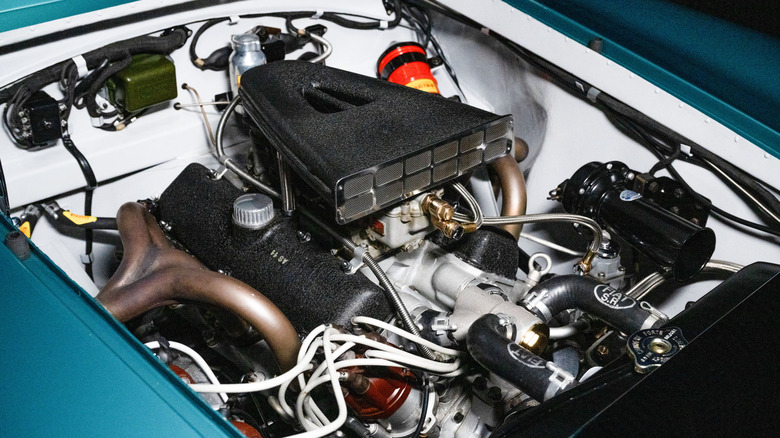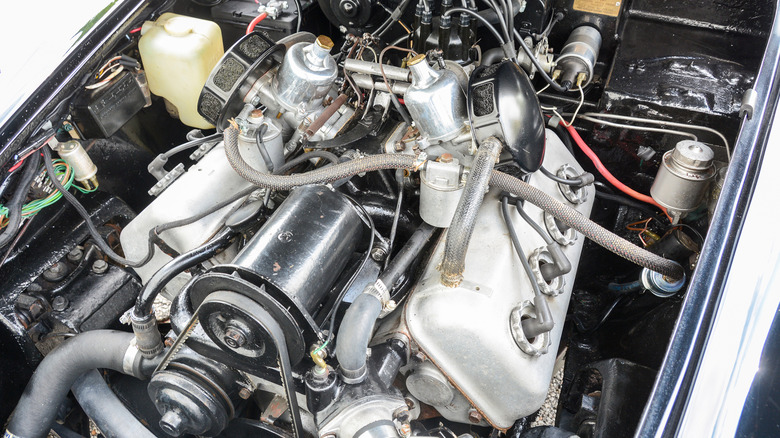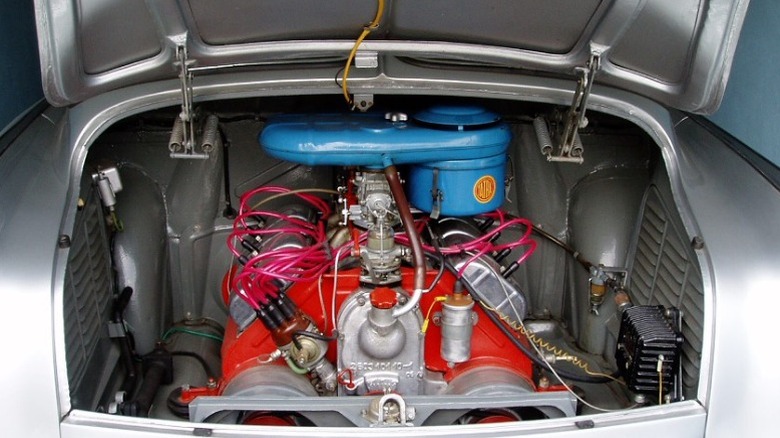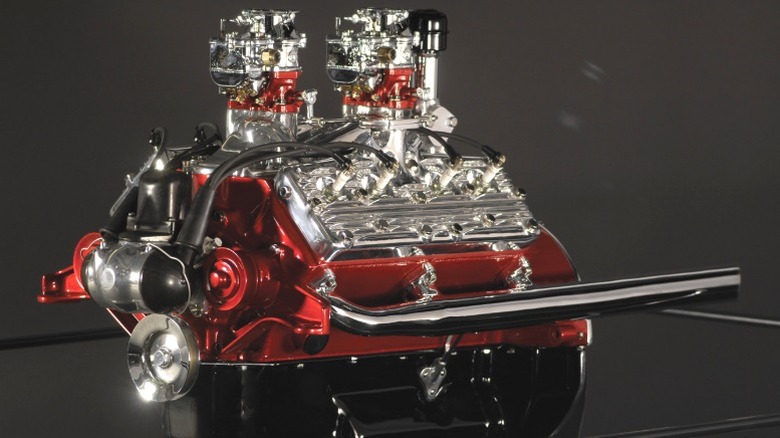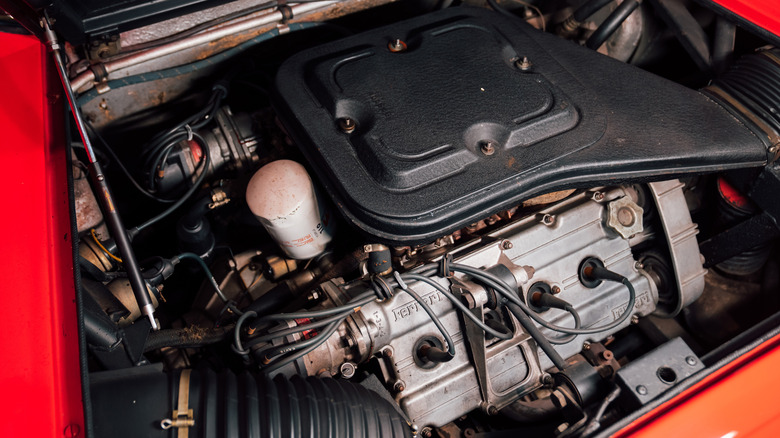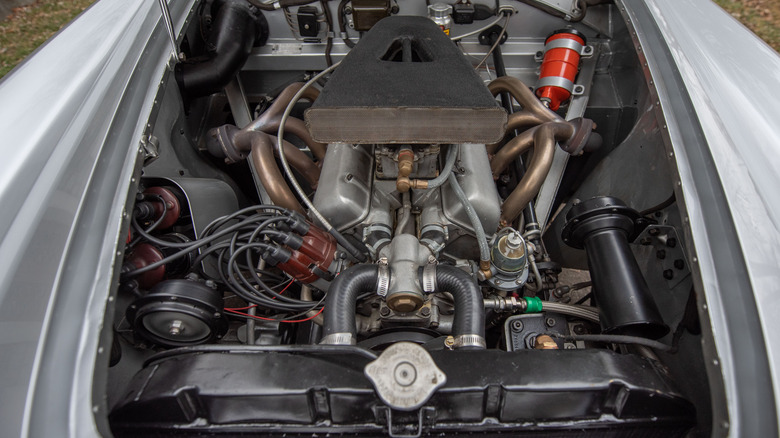5 Of The Smallest V8 Engines Ever Made
If you're like the average petrolhead, the notion of a V8 engine likely first brings to mind large-displacement and big-power made famous by many of the iconic big block engines from the likes of GM, Chrysler, and Ford. Even if your tastes gravitate toward exotic — but no less powerful — flat-plane V8s, you'll still probably be thinking of 4.0-liter and larger V8s like the one in the Lamborghini Temerario. But not every V8 has to be that big, and there have been plenty of compact V8s over the years.
We're not talking about engines that are small for a V8, either. Some have displacements that wouldn't look out of place on a four- or six-cylinder engine. From the 2.0-liter engines from Italian marques Fiat and Ferrari, to the surprisingly small (for an American automaker) 2.2-liter Ford Flathead that debuted in the mid-1930s, and the quirky 2.5-liter Tatra V8, more than a few carmakers have dipped their toes into the world of small V8 engines, be it for taxation purposes or otherwise.
A quick note before we start: there have been more 2.0-liter V8s than we'll discuss here, but we opted not to include them to have a more varied list that could encompass a few lesser-known (but still small) V8s. We have nothing against Lamborghini or Alfa Romeo, but they unfortunately had to take a back seat this time around.
Daimler 2.5-liter V8
Let's kick off our list with a couple of 2.5-liter V8s. The first of the two is less obscure, although it's probably still going to be unfamiliar to most — unless you happen to be familiar with the British auto industry circa WWII.
In 1959, British automaker Daimler (which had nothing to do with Gottlieb Daimler beyond having purchased the rights to use the name) introduced a distinctive, fiberglass-bodied roadster called the SP250 at the New York Auto Show. The sporty SP250 was something of a notable departure for Daimler, whose cars were more likely to transport heads of state than tear up British back roads. Underneath the SP250's hood was a new cast-iron 2.5-liter V8 with hemispherical combustion chambers — yes, just like the Jaguar XK6, the Daimler V8 is one of the handful of non-Chrysler hemi engines to make its way into cars over the years.
The Daimler V8 produced 140 hp and 155 lb-ft of torque, which allegedly gave the SP250 a top speed of around 120 mph and a 0-60 time of roughly 9 seconds. But things at Daimler changed significantly just the following year, when Jaguar acquired it from B.S.A. Jaguar kept the SP250 going, but it also performed an automotive mashup by sticking the 2.5-liter Daimler mill inside a Jaguar Mk2 body to create the Daimler 2.5 Litre V8, later renamed the V8-250. Jaguar eventually discontinued the V8-250 in 1969, and the engine went with it.
Tatra 2.5-liter V8
V8s this small are quite rare in and of themselves, but what if we told you that this particular V8 was air-cooled and sat in the back of the car it powered? No, it's not some mutant Porsche V8 experiment. The Tatra 2.5-liter V8 is one of those Cold War-era creations from behind the Iron Curtain, when cars like the Trabant and the much-maligned Yugo were reality for millions of people and not the hip cult classics they are today.
Tatra was a Czech automobile manufacturer that had survived WWII and been nationalized under the new post-war socialist government. In 1956, the automaker launched the T603, its equivalent of a contemporary Western luxury automobile. It was large, reasonably plush, aesthetically unique (to say the least), and perfect for high-ranking party officials and the more privileged members of the Czech state apparatus. Like earlier Tatra offerings (such as the pioneering Tatra 77), Tatra engineers opted to put the T603's engine in the back, although it's unclear whether this was for aero purposes, as it was on the 77.
Either way, the hemi V8 was reasonably capable, although it shouldn't surprise you that official output numbers are hard to come by. However, most modern sources agree that the engine could make around 100 hp and roughly 120 lb-ft of torque. Interestingly, the T603 also found success on the track, including winning an 84-hour race at the Nurburgring in 1967. Tatra built the T603 until the mid-1970s; its replacement, the T613, had a larger 3.5-liter V8 instead.
Ford 2.2-liter Flathead V8
The V8 engine owes a huge debt to Ford and its Flathead V8, which first debuted in 1932 and was so named because of the flat cylinder heads Ford used. The Flathead V8 brought power to the masses and is sometimes credited for launching hot rodding as we know it, being the engine on which many now-familiar names in performance parts (such as Ed Iskenderian of Isky Cams) cut their teeth.
Amongst the more notable Ford Flathead V8s were the 221 CI V8 that kicked things off and a post-war 239 CI version that made a heady 100 hp. But while both would be considered relatively small for American V8s, there was an even smaller member of the family, a tiny 136 CI (or 2.2-liter) engine that first debuted in the U.S. in 1937. Known as the V8-60 owing to its 60-hp output, Ford introduced the baby Flathead to provide a more fuel-efficient option for customers.
Interestingly, the V8-60 wasn't initially for the American market. The 2.2-liter V8 was intended for Ford's U.K.-built Model 60, and would later power the much more handsome Model 62. Stateside, the V8-60 would most notably find use in displacement-limited racing classes, and a strong ecosystem of aftermarket parts, such as camshafts, pistons, and cylinder heads for the tiny V8 eventually developed. Some builders allegedly managed to use these parts to double the V8's output to a healthy 142 hp, which isn't bad at all.
Ferrari 2.0-liter V8
We'll end our list with a couple of 2.0-liter V8s, the first of which is Ferrari's. Debuting in 1974's Dino 208 GT4, the 170 hp V8 was Ferrari's way of skirting around new Italian tax rules that began heavily taxing engines larger than 2.0 liters. As such, the 2+2-seater 208 GT4 (which became a full-fledged Ferrari starting in 1976) was an Italian-only model, of which only 840 were ever built until Ferrari discontinued it in 1980.
But the 2.0-liter V8's story doesn't end there. Ferrari replaced the 208 GT4 with twin 208 GTB and 208 GTS models that same year. Both were proper two-seater models, with the latter sporting a targa roof. But while the engine stayed at 2.0 liters, power was down for the new models: Instead of 170 hp, the GTB and GTS made 155 hp and 125 lb-ft of torque. The Dino version was already one of the slowest modern Ferraris ever, and so the drop in power likely didn't do the GTB and GTS any favors.
Thankfully, things would soon take a turn for the better. In 1982, Ferrari unveiled the 208 GTB Turbo, followed by a turbocharged 208 GTS the next year. The V8 was still 2.0 liters, but the addition of a single turbocharger pushed power and torque to 220 hp and around 177 lb-ft of torque. It would prove to be the final flourish of this particular small V8, which had come a long way from its humble beginnings.
Fiat 2.0-liter V8
We may have passed up a couple of small Italian V8s, but let's be real: No list of compact eight-cylinder engines would be complete without at least a couple of them. Let's end with another of Italy's 2.0 liters, albeit one of a very different vintage and unsullied by tax-related shenanigans. Fiat's 2.0-liter V8, also known as the Tipo ("Type") 104, powered the Fiat 8V, which debuted in Geneva in 1952
Fiat's V8 used a cast-iron block, aluminum heads, and a narrower-than-usual 70-degree angle for its cylinders (for context, Chevy big blocks used a 90-degree cylinder angle, as did Ferrari's similarly small 2.0-liter V8). Power was anywhere between 105 and 125 hp, depending on the configuration, and it sent that modest power output to the rear wheels via a four-speed transmission. There was also a race-going Tipo 104.004 version of the engine that allegedly made more power, although history seems not to have preserved the 104.004's power output for posterity.
Fiat built 114 8Vs between 1952 and 1954, with a handful of different bodies housing the Type 104 engine and chassis. Fiat built some bodies, but the automaker also provided bare chassis to several Italian coachbuilders, namely Vignale, Ghia, and Zagato. The Ghia-bodied 8V Supersonic, one of many beautiful classic cars you may never have heard of, is likely one of the most sought-after. Multiple examples have sold for more than $2 million at auction over the years. That's about $1 million per liter — quite the value proposition.
